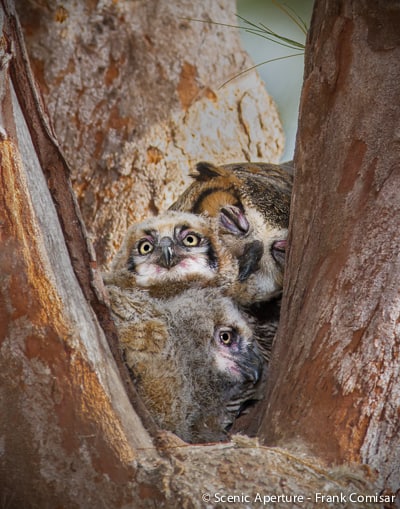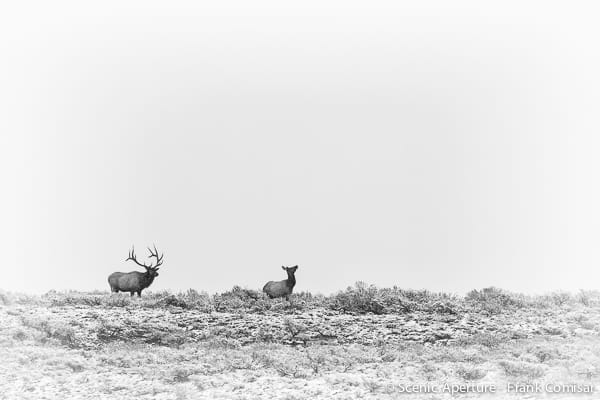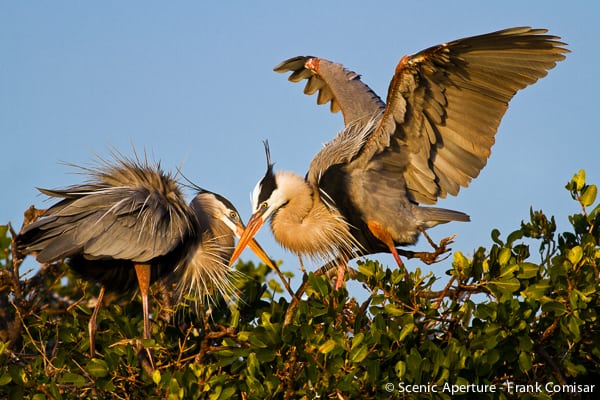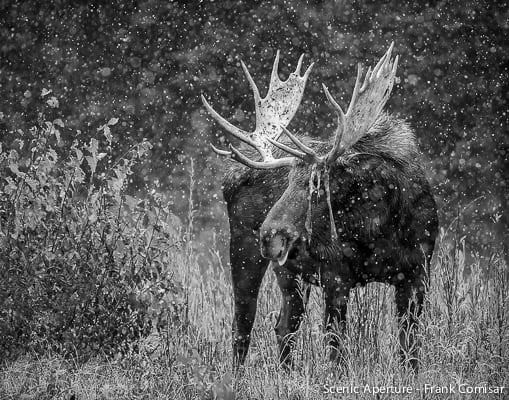There is more to fine art photography of wildlife than a super telephoto lens and a frame full of critter. A properly focused and exposed full-frame image of a stationary wild animal can be a challenging and worthwhile pursuit. I call this type of shot the “field-guide” shot.
That is, it is a perfect image to include in a field guide from which to ID a particular species. In other words, a field-guide image is one that is perfectly exposed, tack-sharp, and fills the frame to show minute details not easily seen by the casual observer.
Obviously, making a field-guide image is no simple matter. However with that said, a field-guide image can feel static and somewhat sterile.

Anyone who has attempted wildlife photography knows that making a field-guide image is much easier said than done. However, despite the difficulty of making a field-guide shot, I believe there is much more to great wildlife photography including equal parts of technical precision (focus and exposure) and artistic judgment.
A compelling composition and creative vision, added to the field guide image, become the secret sauce of fine art wildlife photography. A great wildlife image captures a moment in time that, when viewed after the fact, evokes the photographer’s feelings and emotions at the instant the shutter was clicked. In addition, the fine art wildlife image should tell a compelling story about the animal, its environment, and context.
Fine Art Wildlife Photography
There are several compositional guidelines that are ordinarily non-negotiable for great wildlife photographs. These are the baseline characteristics for any great wildlife image. They are rather simple in concept but not necessarily in execution:
- Clean, out of focus background with no distracting elements
- Eye level point of view
- Diagonals lines (literal or implied)
- Subject entering the frame with plenty of breathing room in front
- No cropped body parts (even if obscured by vegetation)
- Avoid the south end of a north bound animal
Once these basics are mastered, we can move onto more subtle compositional techniques. Let’s consider three compositional varieties for fine art wildlife photography:
- Intimate Portrait
- Environmental landscape
- Environmental Interactive
Intimate Portrait
Well-executed wildlife portraits have characteristics and features similar to well-executed human portraits. The subject’s eyes are critical. Eye contact creates an emotional connection between the viewer and the subject. A wildlife portrait where the animal is looking away is not nearly as strong as one where the photographer captures eye contact. Introduce a catchlight (A “catchlight’ is simply the highlight of a light source reflected off the surface of the eye), and a blank stare is transformed into personality and emotion.

Posture is important too. Head and extremity position should be natural and flattering, just like with human portraiture. Diagonals, implied or literal, create dynamic and energetic compositions.
Intimate portraits demand simplicity. You must isolate the subject and avoid distracting background clutter. Depth of field control and a low point-of-view can be helpful here. An eye level point of view and a shallow depth of field will frequently create a soft, out-of-focus background that enhances the subject rather than distracts from it.
Environmental Landscape
An environmental landscape composition purposely includes the subject’s surroundings. As such, it provides context. The animal can be a relatively small compositional element in the scene. It’s basically it’s a well-composed landscape photo that includes wildlife. Fundamentally, an environmental landscape helps tell a story. By its very nature, it can reveal such things as the animal’s location, the season, and time of day.

Unlike the field guide image and intimate portrait, the environmental landscape helps connect the subject to its environment. In addition, it helps connect the viewer to the photographer’s experience. Where the field guide image can feel sterile, the environmental landscape feels alive and depicts the natural world in which the animal lives.
Environmental Interactive
An environmental interactive composition captures wildlife in action. It captures your subject’s behavior and interaction with other animals. Such behavior might include feeding, hunting, migration, nest building, mating, grooming, fighting or any other normal activity. These images include more of the animal’s surroundings thana portrait but less than an environmental landscape. Just enough of the animal’s surroundings are included to tell the story. Usually it doesn’t take much.

Basically, the environmental interactive composition captures the life and times of the animal. Personally, I find this to be the most challenging and satisfying type of wildlife photograph. Care must be taken to not unintentionally alter the normal behaviors you are trying to capture. Obviously, there are a lot of variables, some of which are beyond the photographer’s control. Sometimes it’s better to be lucky than good. However, when everything comes together, the results can be spectacular. Environmental interactive images are the “money shot” that frequently elicit an emotional reaction from viewers. For me, I know I’ve nailed an environmental interactive shot by viewer’s comments such as “Oh my, how close were you”, or “The chicks are so cute”.
Fine Art Photography
To sum up, fine art wildlife photography requires a healthy combination of technical precision and artistic judgment. At the risk of over-simplification, a great wildlife image should include most, if not all, of the characteristics from both the technical and artistic columns below:
Technical
- Tack sharp eye
- Out-of-focus background
- Low noise
- Maximum pixels (min crop)
- Eliminate “lazy” flaws:
- Crooked horizon
- Dust spots
- Cropped edge elements
- Blown highlights
Artistic
- Eye contact
- Catchlight in eyes
- Compelling composition
- Contextual background
- Draws the viewer in
- Emotional connection
- Tells a story
- Conveys a feeling

It would be nice if fine art wildlife photography were completely formula driven. Unfortunately, it’s not that easy. However, with practice, research, and persistence, you can use these compositional techniques as sort of a template from which you can begin your quest for great wildlife photography.
The post From Field Guide to Fine Art Photography appeared first on Scenic Aperture.
Frank Comisar
Frank Comisar is a nature photographer who loves to help others make beautiful photographs. His photography interests are varied and range from landscapes to wildlife. He shoots landscapes, wildlife, and nature for the purpose of capturing a moment in time that when revisited, portrays the natural beauty of the places visited and the creatures that live there. His goal is to not merely provide a visual and technical documentation of the scene in front of the lens. Rather, it is to render the scene in an artistic and creative way that not only provides context to the image, but also captures the feeling and essence of the moment.

Leave a Reply